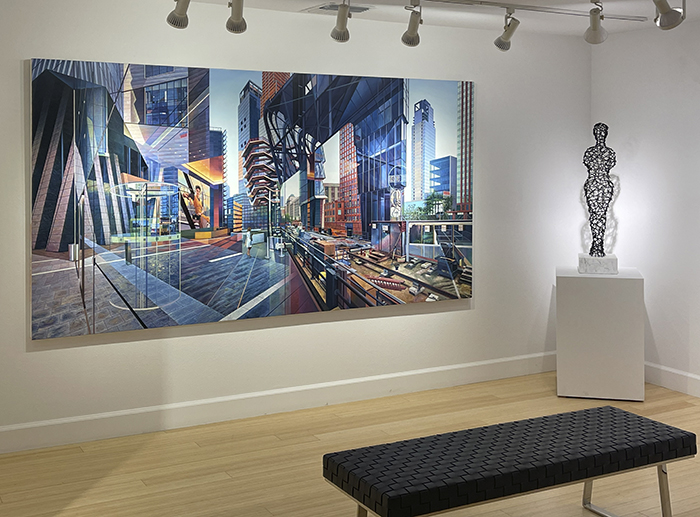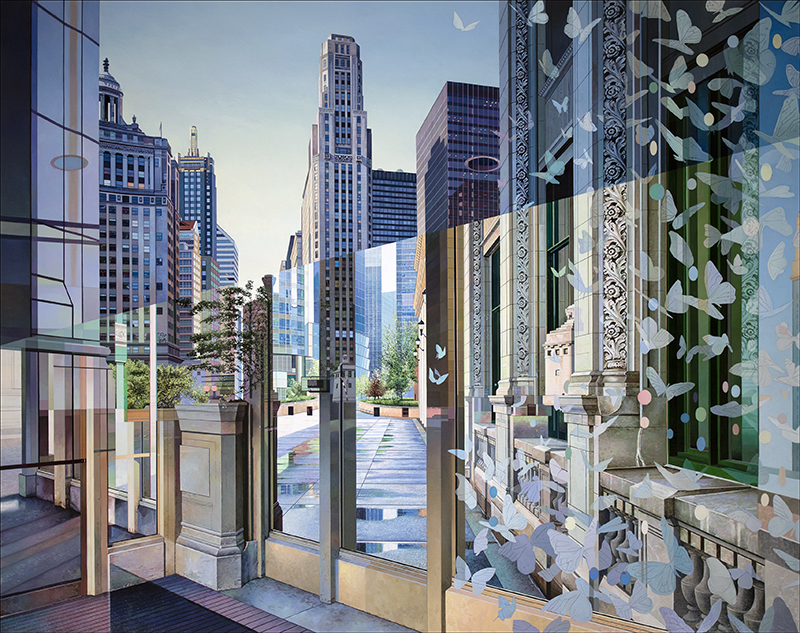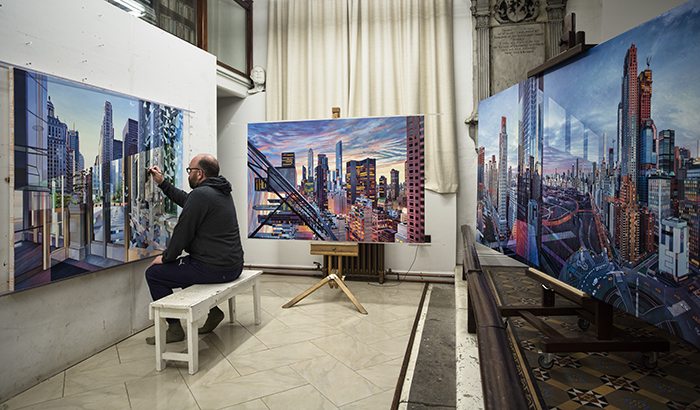
A World "Neither Here nor There" as Portrayed by Nathan Walsh
Nathan Walsh’s talent and years of mastery of architectural drawing techniques have catapulted him into a fantastic hyperrealist artist. Nathan specializes in changing perspectives and rendering details in urban landscapes. At present, he is committed to subtly combining differences in time and space to create a dreamlike multiverse world which immerses and yearns for more.
Childhood memories, impressions from travel, and the surrounding environment have become reference points for Nathan’s paintings over the years. From these reference points, he adds details, such as reflections of light. textures of the street, and layers of colors, and then create buildings and landscapes from various perspectives. As a result, his paintings are never dull with so many details and surprises for the eyes to see.
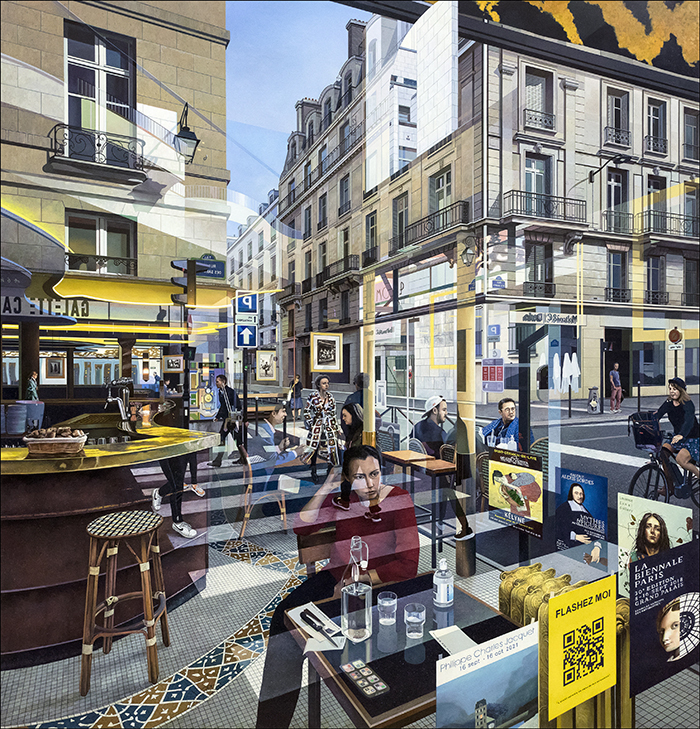
From his recent works, such as “Rue des Saints” and “Monarchs Drift”, viewers can see Nathan’s spirit of seeking change. These two paintings have added such elements and techniques that different scenes can be blended without conflict; they have a more fluid and penetrating sensibility; outlines of a dynamic, multiverse world. He cleverly uses the painting technique of the vanishing point (two parallel lines will always converge at a vanishing point far away from the viewer) to transform and sublimate to provide more imaginary space for the viewer.
We are honored to be able to interview this talented artist. In the interview below, he describes his painting skills and state of mind in detail. We hope it will inspire the readers’ imagination and appreciation.
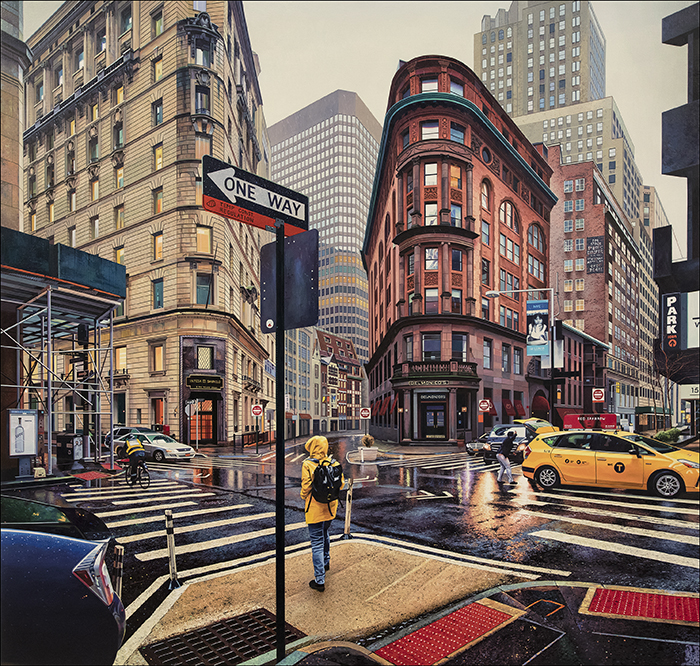
Q: Your cityscape paintings are absolutely magnificent. They take viewers into worlds that are nostalgic yet bewilderingly in astonishment. First of all, please share with us the training background that provides you with such a strong foundation in architectural drawings.
A: I followed a fairly traditional route through art education in the UK: foundation courses, degree, then masters degree. I was fortunate to be taught by two exceptional realist painters on my masters degree, Steve Whitehead and Clive Head. Although Clive left to paint full time whilst I was still studying I maintained a friendship with him for many years afterwards. Although this was not a formal teaching relationship, I believe his advice and willingness to share knowledge has been pivotal to my development.
Around the mid-2000s, realism, and specifically photorealism, was enjoying a flourish of attention, particularly in Europe. European artists, such as Clive and Ben Johnson, were prominent in many of the museum and gallery shows that took place at this time. It became evident to me at this point that it was important to try to extend the visual language of the photorealists instead of merely repeating the lessons of the past. Crucial to this was abandoning one of the main tenets of photorealist painting – transferring imagery from source to canvas through mechanical or semi-mechanical means. Instead of projecting or tracing imagery, new strategies to building pictorial space had to be explored. By applying simple then increasingly complex ways of drawing in perspective allowed me to become less and less dependent on photographic imagery and its manipulation. Around 2005 many of my paintings were constructed via one-point perspective. By 2013 individual paintings often had hundreds of separate vanishing points, multiple horizon lines and station points. Through this evolution I was able to take full ownership of the drawing process and how pictorial space can be imagined.
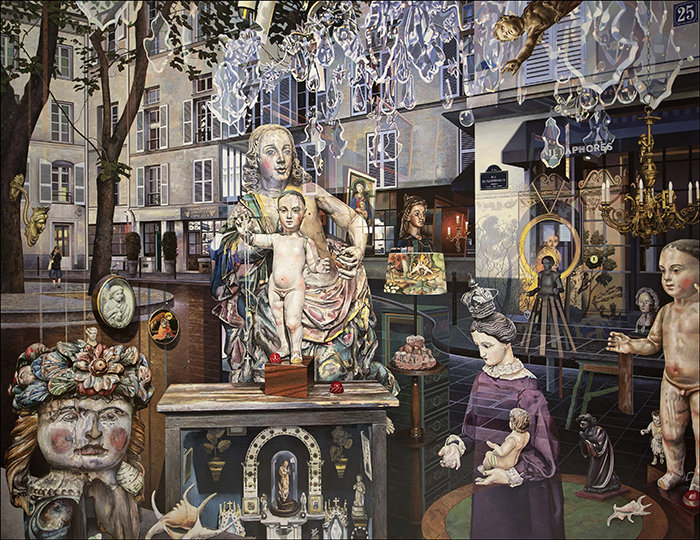
Q: What are the main themes in your paintings and how have they changed over time?
A: I’ve always been drawn to travel and adventure. Exploring new cities and environments has always offered up opportunities for making new paintings. As my work started to get shown outside my home country, it made sense to make the most of my visits to exhibition openings and use my time to gather new reference material through photography and sketchbook drawing. Early on my works were quite literal in nature, describing in paint various surfaces encountered within the urban landscape. The paintings were often celebratory of the cities they were exhibited in. The goal was to universalise the experience of being within a modern city.
Over time, I believe my vision has become more and more personal in nature. The pandemic brought these ideas to the forefront of my practice. Instead of going out and finding subject matter to paint, I began to think about how material I’d collected in the past could be used in a more experimental manner.
This thinking led to my most recent painting, ‘Metaphores’. Since 2017, I have been living and working in a converted Welsh methodist chapel. Over this period the property has become home to a collection of objects which are either linked to the building or connected to my painting practice. In some ways the chapel has become an extension of my studio, full of symbols and reference points which interlink to what I’m exploring through drawing and painting. ‘Metaphores’ started from a series of photographs I’d taken years earlier of an antique shop in Paris. However, it quickly became a fluid stage set of found objects, patterns, paintings and invented reflections. On one level it plays with layers of interior, exterior, and reflected space. In addition it explores my relationship to the notion of making objects and my avid interest in art history. From the celebration of physical travel, my work has shifted in nature to the exploration of inner space.
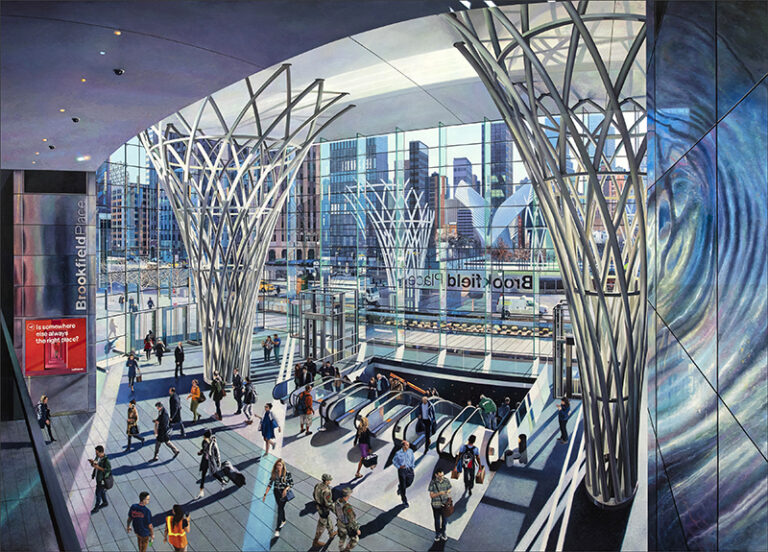
Q: Convergences and divergences of dimensions are fluidly portrayed in your paintings. Please tell us more about these concepts and how you navigate these complex worlds with your brushes.
A: I think this is perhaps tied up with how the paintings are constructed. Separate vanishing points offer a definite way of fixing objects in space. These points get grouped into zones of activity, concentrating or diffusing visual material. Although I’ve been working using similar methods for years, even on the more literal work of the early 2000’s, it’s certainly helped when developing the more involved and immersive paintings I’m making today. Now I’m more confident in putting disparate material together; I can suggest layered imagery which floats within the picture plane instead of one element occupying one specific area. This is allowing for the creation of dreamlike spaces which open up the imagination.
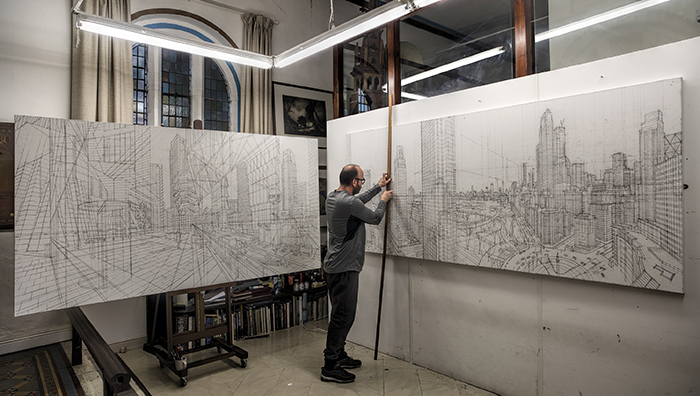
Q: Please share with us some of your architectural drawings, the themes, and the types of buildings that attract you the most.
A: Drawing plays an important aspect in my studio practice, from the visual notes I make on-site to the complex blueprints that underpin my paintings. Instead of mimicking reality or photo-based images, these working drawings allow me to create an alternate reality built from a process of making and then revising lines and forms. The recent working drawings I include here lend themselves to a methodology of construction and deconstruction. The cafes, bus stops, and museums are presented as composites of interior, exterior, and reflected space. For all their exactitude, they are not fixed in nature but exist in multiple states at the same time. Earlier work of mine tended to focus on contemporary architecture but currently, I’ve become more interested in combining architecture from different periods. The key goal, even if dealing with the ancient subject matter, is to try and present a fresh take on the material which hasn’t been seen before.
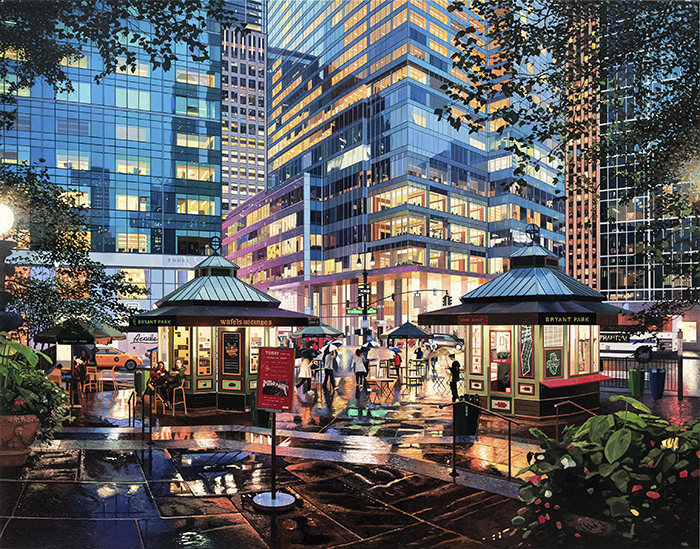
Q: Your usage of perspective is brilliant. It not only takes the viewers to a super realistic sense but also extends to another world, the world of the subconscious. Please elaborate on this subject, if you don’t mind.
A: My paintings generally start with a period of reportage photography by making a commitment to redrawing raw material within a perspectival space that automatically shifts their nature away from the source material. The problem with the camera as a tool for painters is that a photograph flattens space, whilst the goal of any serious painter is to create and manipulate their own space. Perspective is useful in this aspect in that it allows for the suggestion of deep space and atmosphere.
My use of perspective no longer follows any fixed rules or logic; in the more recent works I’ve started to abandon it altogether. The root problem has been replacing one mechanical language with another. Therefore, the way I approach constructing paintings is, I believe, more fluid in nature – I will adopt and reject methods of working as I go along.
I think my most successful paintings do suggest a heightened reality that runs parallel to our own. Whilst they make reference to our own world, these new painted realities obey laws I set down through the process of making. Colour theory, photography, perspective, and the material qualities of paint all play a role in building this vision.
What runs through my paintings from different periods is their meticulous nature. Even as they have started to splice different locations and time periods together they still have precision and clarity with the aim being to convince the viewer of their credibility..
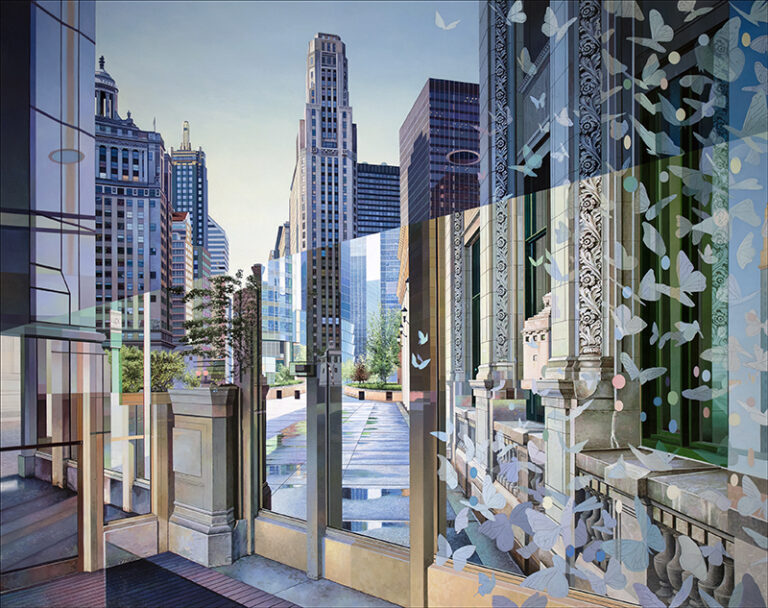
Q: Please share with us some of your recent paintings and the stories behind them.
A: I think ‘Rue des Saints’ and ‘Monarchs Drift’, which have been made over the past eighteen months, are good indications of how my recent thinking has influenced how my paintings currently look. Often it seems as an artist that there is a time lag between having ideas for paintings and then being actually able construct works which visualise these ideas. It’s taken significant reflection and a willingness to evolve to make something close to what I wanted.
‘Rue des Saints’ is a painting based on a busy cafe in the 7th arrondissement of Paris. Instead of a literal view, the painting explores interior, exterior and reflected space within its square format. The starting point was Eugene Atget’s uncanny shop front photographs, three of which are reproduced in miniature within the composition. However, as the initial drawing developed, pictorial elements became less fixed in nature, forms started to overlap and bleed into each other. Instead of the static nature of a photograph, the painting became a stage set where found imagery could float in and out of a real location. Exhibition posters, real and invented, populate the space along with picture frames, aerial photographs, and signage. The result is a free flowing composite scene, which suggests a world which is ‘neither here nor there’.
Whilst this approach does have some parallels with the Cubist experiments of the early twentieth century, the goal was not to fracture then reassemble form, but to present a heightened and shifting view of reality. Akin to experiencing a lucid dream I hope the painting is still realist in nature but only insofar that the world it presents is coherent and persuasive.
‘Monarchs Drift’ explores a combination of interior, exterior, and reflected space but in this case it features two disparate cityscapes, Chicago and San Francisco. The resultant painting has an hallucinatory quality which is ‘neither here nor there’ and exists as a world in transition, between fully formed states. It is realist in nature but only insofar as the spaces it suggests are cogent and persuasive. The title refers to the migration of the Monarch butterfly which has parallels to a trip I made in 2013 across America.
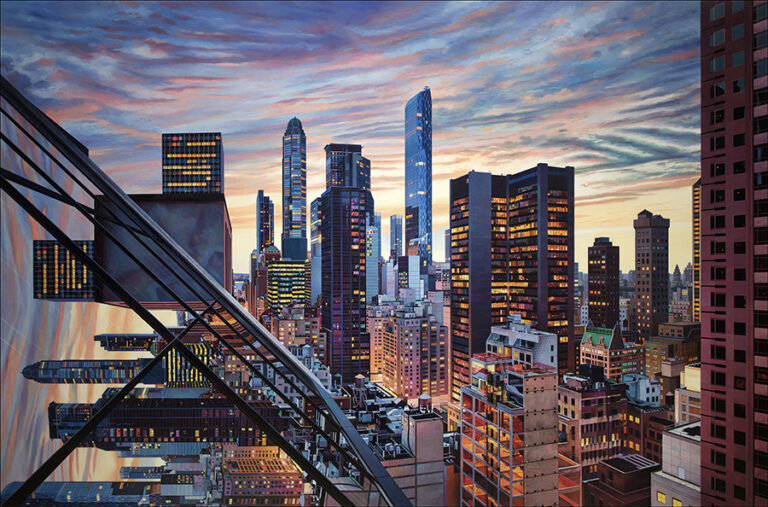
Q: Do you have any exhibition or project that you wish to share with our readers?
A: I haven’t got any fixed plans for exhibitions as most of the work I’ve made to date is already in private collections. However, I am excited by the prospect of the new work I have underway.
Over the past few months I’ve been developing a series of drawings based on visits to the Natural History Museum in London. My first visit to this wonderful building was as a five year old with my mother. I still have the exhibition catalogue from that trip so it must have had a significant effect on my young mind. Instead of a literal description of the museum, I have been combining views from different locations within the space. The drawings also include examples of Victorian taxidermy and sculpted animal forms which hopefully add a playful air to the compositions. The goal in 2023 is to make a painting based on these experiments. I do try with everything I make to extend the scope of what is possible. This could be as simple as increasing the number of pictorial elements present or introducing a more dynamic colour palette.
The influence of Piranesi’s imaginary prisons looms large within these drawings, something which also runs through another body of work which is pinned up on my studio walls. Last December I visited Rotterdam with the intention of collecting material for a potential commission. Perhaps the highlight of my visit was visiting the Depot Boijmans museum which is presented as a fully accessible art depot. The building explores the many facets of art storage, handling, restoration, record making and presentation. Fourteenth century polychromed sculptures are shown next to Basquiat paintings which is unexpected and exciting. I’ve started making drawings based on this experience which I want to connect with the spirit and themes which run through the building. These two projects should keep me busy through 2023 and beyond.
I think the opportunity and possibility of making more ambitious and involved work is something which keeps me excited about walking into the studio every morning.
